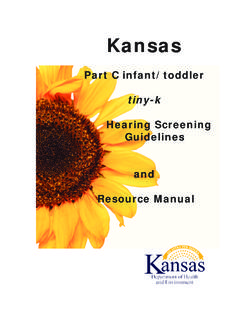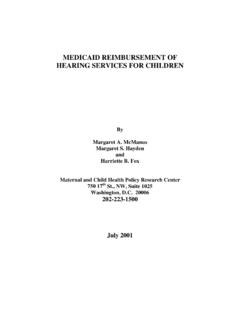Transcription of CDC's Progress in Detecting Infant Hearing Loss
1 CDC s Early Hearing Detection and Intervention (EHDI) is making clear Progress in supporting the early identification of deaf and hard of Hearing (D/HH) children. The earlier children are identified with Hearing loss and start getting intervention, the more likely they will reach their full potential. CS294435-ANovember 30, 2018 CDC s Progress in Detecting Infant Hearing Loss98 percent of infants are now screened for Hearing loss usually before leaving the 2005 over 58,000 D/HH infants in the have been identified early.$200 million in education costs are saved each year in the due to newborn Hearing Hearing loss early is importantHearing loss is one of the most common birth defects.
2 When left undetected, a Hearing loss can delay a child s speech and language development as well as his or her thinking, learning, and social skills. CDC-supported research show meeting the 1-3-6 Benchmarks results in better vocabulary development for children who are CDC is making a difference The CDC EHDI program provides assistance to all states and territories to support the early identification of all D/HH infants. CDC is responsible for collecting and analyzing EHDI data from across the United States. CDC funds the development and use of systems and data tools that help states and territories ensure D/HH children receive essential services Newborn Hearing screening, which is usually done soon after birth.
3 Diagnostic Hearing evaluation, which involves tests to confirm if a child is D/HH. Early intervention services help D/HH children with learning language and other important Professionals Use These Important 1-3-6 Benchmarks Before one month of age: Hearing Screening Before three months of age: Hearing Evaluation Before six months of age: Early Intervention Hearing screening is the first Hearing service to determine if a baby may have a Hearing evaluation is a comprehensive test to determine if a baby has Hearing loss and the severity and type of Hearing mo3 mo6 moCDC s data show clear Progress Better data systems and tools are helping states and territories tomake sure more D/HH infants are identified early.
4 The percent of infants receiving a Hearing evaluation (test) before thebenchmark of 3 months of age has increased from 52 percent in 2005to 76 percent in supports states CDC funds 44 states and territories to develop and improve datainformation systems, which help make sure all infants receiverecommended services. CDC helps states and territories leverage advances in healthinformation technology to collect, use, and share steps for CDC Expand the capacity of states and territories to collect and usecomplete and accurate data. Promote adoption of standards and quality measures to improveEHDI data. Support research about ways to further increase the benefits ofearly efforts are needed to Make sure all D/HH infants are identified early by documenting thatthey have received critical screening and diagnostic services.
5 Assess Progress and support program improvement through timelydata analyses. Strengthen information exchange between health providers andinformation systems to help coordinate the delivery of EHDI services for infants. Provide assistance to states and territories to support theenhancement and use of their EHDI data of infants identified early as D/HH has increased37,0006,0005,0004,0003,0002,000 1,0000200520162,6346,337 CDC Funded States and TerritoriesFunded Territories American Samoa Guam Marshall Islands Puerto Rico Northern MarianaIslandsFundedNot FundedReferences: 1 Data obtained from CDC Hearing Screening and Follow-up Survey at 2 Gross, SD. Education cost savings from early detection of Hearing loss: New findings.
6 Volta Voices 2007;14(6):38-40. 3 Yoshinaga-Itano C, Sedey AL, Wiggin M, Chung W. Early Hearing Detection and Vocabulary of Children with Hearing Loss. Pediatrics. 2017:140(2):e20162964 For more informationvisit: email: call: 800-CDC-INFO Follow us on Twitter: @CDC_NCBDDD

















